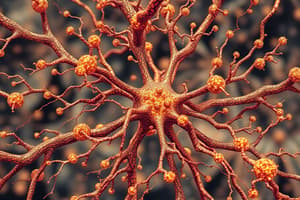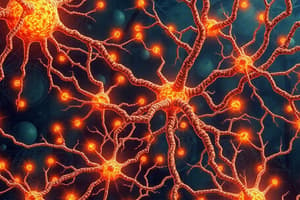Podcast
Questions and Answers
What is the primary function of microtubules within a neuron?
What is the primary function of microtubules within a neuron?
- Transporting substances within the neuron. (correct)
- Receiving neurotransmitters.
- Providing energy for neurotransmitter release.
- Storing neurotransmitters.
Which of the following best describes the role of the synaptic cleft in neuronal communication?
Which of the following best describes the role of the synaptic cleft in neuronal communication?
- It provides energy for neurotransmitter release.
- It contains synaptic vesicles filled with neurotransmitters.
- It contains receptors that receive neurotransmitters.
- It is the space where neurotransmitters travel to reach the postsynaptic membrane. (correct)
Which of the following neurotransmitter inactivation methods involves glial cells?
Which of the following neurotransmitter inactivation methods involves glial cells?
- Diffusion
- Astrocyte Uptake (correct)
- Reuptake
- Degradation
What is the correct order of events in anterograde synaptic transmission?
What is the correct order of events in anterograde synaptic transmission?
What distinguishes metabotropic receptors from ionotropic receptors?
What distinguishes metabotropic receptors from ionotropic receptors?
Which neurotransmitter is primarily associated with muscle movement, learning, and memory?
Which neurotransmitter is primarily associated with muscle movement, learning, and memory?
How do neurotransmitters contribute to synaptic plasticity?
How do neurotransmitters contribute to synaptic plasticity?
Which of the following accurately describes the process of exocytosis in the context of synaptic transmission?
Which of the following accurately describes the process of exocytosis in the context of synaptic transmission?
What is the role of calcium ions ($Ca^{2+}$) in anterograde synaptic transmission?
What is the role of calcium ions ($Ca^{2+}$) in anterograde synaptic transmission?
Which of the following describes a way neurotransmitters can be removed after they have acted on the postsynaptic cell?
Which of the following describes a way neurotransmitters can be removed after they have acted on the postsynaptic cell?
Flashcards
What is a Neurotransmitter?
What is a Neurotransmitter?
A chemical messenger that influences the postsynaptic neuron, enabling communication between neurons.
What is the Synaptic Cleft (Gap)?
What is the Synaptic Cleft (Gap)?
The space between neurons where neurotransmitters are released and travel to bind to receptors on the postsynaptic neuron.
What is Anterograde Synaptic Transmission?
What is Anterograde Synaptic Transmission?
- Action potential reaches the axon terminal. 2. Calcium binds to calmodulin. 3. Vesicles release neurotransmitters (exocytosis). 4. Neurotransmitters bind to receptors. 5. Inactivation.
What is Exocytosis?
What is Exocytosis?
Signup and view all the flashcards
What are the four ways neurotransmitters are removed from the synapse?
What are the four ways neurotransmitters are removed from the synapse?
Signup and view all the flashcards
What is GABA?
What is GABA?
Signup and view all the flashcards
What is Glutamate?
What is Glutamate?
Signup and view all the flashcards
What is a Metabotropic Receptor
What is a Metabotropic Receptor
Signup and view all the flashcards
How do Neurons communicate?
How do Neurons communicate?
Signup and view all the flashcards
What are Ionotropic Receptor?
What are Ionotropic Receptor?
Signup and view all the flashcards
Study Notes
- Neurons communicate and adapt by sending and receiving messages, utilizing neurotransmitters, and adapting synapses.
- Neurons communicate through electrical and chemical signals.
- The communication occurs in two steps: electrical signals (action potential) traveling along the axon to the synapse, and chemical signals via neurotransmitters, which are released at the synapse to excite or inhibit the next neuron.
- A neurotransmitter is a chemical messenger that influences the postsynaptic neuron.
- Neurotransmitters function in three ways: carrying a message forward (anterograde transmission), sending messages backward (retrograde transmission) to regulate presynaptic release, and changing the structure of a synapse (synaptic plasticity).
- A chemical synapse involves neurons transferring messages using neurotransmitters.
Key Parts of a Synapse
- Presynaptic Terminal (Axon Terminal) contains synaptic vesicles filled with neurotransmitters.
- Microtubules transport substances within the neuron.
- Mitochondria provide energy for neurotransmitter release.
- Synaptic vesicles store neurotransmitters.
- The synaptic cleft (gap) is the space in which neurotransmitters travel.
- The postsynaptic membrane contains receptors that receive neurotransmitters.
- Postsynaptic receptors bind neurotransmitters and trigger a response.
Steps of Anterograde Synaptic Transmission
- Action potential reaches the axon terminal, opening voltage-sensitive calcium (Ca2+) channels.
- Calcium binds to calmodulin, forming a complex.
- Vesicles release neurotransmitters into the synapse (exocytosis).
- Neurotransmitters bind to receptors on the postsynaptic neuron.
- Neurotransmitters are removed or broken down (inactivation).
- Exocytosis is an active process where neurotransmitters are packaged into vesicles, moved to the cell membrane, and released.
Neurotransmitter Inactivation
- After neurotransmitters complete their job they must be removed from the synapse via:
- Diffusion, where neurotransmitters drift away.
- Degradation, where enzymes break them down.
- Reuptake, where transporters return neurotransmitters to the presynaptic neuron.
- Astrocyte uptake, where glial cells absorb excess neurotransmitters.
- Neurotransmitters are chemical messengers that can be excitatory (increase activity) or inhibitory (decrease activity).
Small-Molecule Neurotransmitters
- Acetylcholine (ACh) facilitates muscle movement, learning, and memory.
- Epinephrine (EP) and Norepinephrine (NE) contribute to alertness and stress response.
- Dopamine (DA) is involved in reward, pleasure, and movement.
- Serotonin (5-HT) affects mood, sleep, and appetite.
- GABA is the main inhibitory neurotransmitter and reduces brain activity.
- Glutamate is the main excitatory neurotransmitter and increases activity.
Neurotransmitter Versatility
- Neurotransmitters can be excitatory at one location and inhibitory at another.
- Two neurotransmitters can work together (synergistic effect) to strengthen signals.
- Neurotransmitters can act outside the brain as hormones, traveling through the bloodstream.
- Neurotransmitters bind to specific receptors to send signals.
- Two main categories of neurotransmitter receptors: ionotropic and metabotropic.
Ionotropic Receptors
- Have an ion channel where ions (Na+, K+, Cl-, Ca2+) can enter.
- They cause immediate effects by changing membrane voltage.
- An example is nicotinic ACh receptors in muscles.
Metabotropic Receptors
- They do not have an ion channel; instead, they activate a G-protein.
- They trigger slower, longer-lasting effects through second messengers.
- Examples include dopamine and serotonin receptors.
Studying That Suits You
Use AI to generate personalized quizzes and flashcards to suit your learning preferences.






